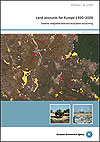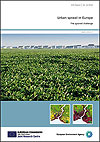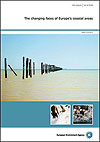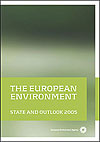Landscapes are as much idealised vision as reality. The way we perceive landscapes, the attraction we feel to some of them, and our feelings when conflicts arise over
the use of land, are all matters of extreme importance for conservation and future human welfare. A landscape is essentially a photograph of what is going on; it reveals,
in short, who we are. At the same time landscapes are also dynamic expressions of continually changing natural processes (climatic, physical, biological) and changes
caused by human activity.
Landscape analysis requires the consideration of different factors not equally easy to apply. The spatial dimension must be considered, as must the temporal component.
It is especially important to know both where and when change is happening, given the uneven distribution and value of ecological goods and services across Europe, the
vast range of activities that impact on them and the changing character and intensity of these impacts over time.
Land and Ecosystem Accounting (LEAC) is a powerful tool that helps us to better understand and protect the environment. Land and ecosystem accounts are systemic
descriptions of how related assets change over time and space (where an asset is anything valuable or useful). It works by providing a single overview where the social,
economic and environmental resources on which our wellbeing depends can be linked within a single framework.
“Land and Ecosystem Accounting provides the overview that we need to better protect and maintain our natural capital; both now and into the future”, said Professor
Jacqueline McGlade, Executive Director of the EEA. Professor McGlade was co-chairing the International workshop on ecosystem and natural capital accounting together with
Mr Ivo Havinga, Chief Economic Statistics Branch, UN Statistical Division.
A short summary is available in conjunction with the workshop, as well as the new EEA Technical report, “Land accounts for Europe 1990-2000 - Towards integrated land
and ecosystem accounting” which was launched today.
“The accounting framework will eventually allow us to connect the natural system to the economic system”, said Mr Ronan Uhel, Head of the EEA Spatial Analysis group.
“These accounts are tools that help us understand how well the environment would be able to withstand change and still provide us with the services and resources we need
in the future”.
Workshop
Workshop agenda and list of participants
Background information on land and ecosystem accounting
Non-technical background note
See: summary
 Land accounts for Europe 1990-2000 – Towards integrated land and ecosystem accounting
Land accounts for Europe 1990-2000 – Towards integrated land and ecosystem accounting
The EEA has a European Topic Centre on Terrestrial Environment. From the website readers can navigate to
tools that allow readers themselves to perform basic land cover accounts by connecting directly to the LEAC database.
Other related EEA outputs
 Urban sprawl in Europe - The ignored challenge
Urban sprawl in Europe - The ignored challenge
The growth of cities in Europe has historically been driven by increasing urban populations. However, today, even where there is little or no population pressure, a
variety of factors are still driving urban sprawl. These are rooted in the desire to realise new lifestyles in suburban environments, outside the inner city. The mixture
of forces behind these trends include both micro and macro socio-economic trends, which are resulting in sprawling cities all over Europe.
 The changing faces of Europe's coastal areas
The changing faces of Europe's coastal areas
This EEA report provides information on the state of the environment in the coastal areas of Europe.
 The European environment - State and outlook 2005
The European environment - State and outlook 2005
Parts A and B of this report contain an up-to-date integrated assessment of Europe's environment including land use.
 PRELUDE - PRospective Envrionmental analysis of Land Use Development in Europe, explores what European landscapes may look like 30 years from
now.
PRELUDE - PRospective Envrionmental analysis of Land Use Development in Europe, explores what European landscapes may look like 30 years from
now.
Links to related land use websites
Yann Arthus Bertrand
Yann Arthus Bertrand is a French photographer who captures changing landscapes from a small aeroplane.
 UNEP
One Planet Many People: Atlas of Our Changing Environment
UNEP
One Planet Many People: Atlas of Our Changing Environment
Through a combination of ground photographs, current and historical satellite images, and narrative based on extensive scientific evidence, this publication illustrates
how humans have altered their surroundings and continue to make observable and measurable changes to the global environment.
 Corine land cover 2000
Corine land cover 2000
CLC2000 uses photo-interpretation of satellite images to show the impact of human activities on land use over a ten-year period between 1990 and 2000. The spread of
housing, food production and transport networks are all illustrated by the system. It also shows land cover changes in ecosystems, such as forests and lakes.
Document Actions
Share with others